Themed collection Spotlight Collection: Bioinorganic Chemistry

Metal complexes for catalytic and photocatalytic reactions in living cells and organisms
This review presents discrete metal complexes that catalyse or photocatalyse reactions within living cells or living organisms.
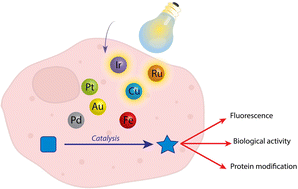
Chem. Sci., 2023,14, 409-442
https://doi.org/10.1039/D2SC05672K
O–O bond formation via radical coupling in a dinuclear iron water oxidation catalyst with high catalytic activity
A mechanism involving O–O bond formation via radical coupling of two subunits is proposed for a dinuclear iron complex. The mechanism can proceed at low overpotentials and agrees with the experimental kinetics.

Dalton Trans., 2024,53, 2456-2459
https://doi.org/10.1039/D3DT03178K
A porphyrin-based molecular cage guided by designed local-electric field is highly selective and efficient
The present work outlines a general methodology for designing efficient catalytic machineries that can easily be tweaked to meet the demands of the target reactions.

Chem. Sci., 2023,14, 10329-10339
https://doi.org/10.1039/D3SC01720F
Outer coordination sphere influences on cofactor maturation and substrate oxidation by cytochrome P460
Spectroscopy and kinetics are used to evaluate the role of the secondary coordination sphere in substrate/product binding as well as reactivity in the nitrification enzyme cytochrome P460.

Chem. Sci., 2023,14, 8295-8304
https://doi.org/10.1039/D3SC02288A
Disulfide radical anion as a super-reductant in biology and photoredox chemistry
Peak and half-peak potentials poorly approximate standard reduction potentials (E0), especially for compounds that dissociate upon reduction. We determine E0 of disulfides and show cysteine disulfide radical anion to be a powerful biological reductant.

Chem. Sci., 2023,14, 6876-6881
https://doi.org/10.1039/D3SC01867A
Horizontal proton transfer across the antiporter-like subunits in mitochondrial respiratory complex I
Proton transfer in the membrane domain of complex I.

Chem. Sci., 2023,14, 6309-6318
https://doi.org/10.1039/D3SC01427D
Unveiling the impact of oxidation-driven endogenous protein interactions on the dynamics of amyloid-β aggregation and toxicity
We illuminate that cytochrome c (Cyt c) directly interacts with amyloid-β (Aβ) and alters Aβ amyloidogenesis in a peroxide-dependent manner, which demonstrates its new role towards the amyloid pathology associated with Alzheimer's disease.
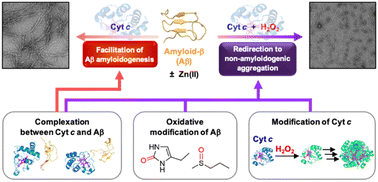
Chem. Sci., 2023,14, 5340-5349
https://doi.org/10.1039/D3SC00881A
An artificial metallolyase with pliable 2-His-1-carboxylate facial triad for stereoselective Michael addition
We repurposed the metal-binding site of a cupin superfamily protein into the 2-His-1-carboxylate facial triad, which is the common motifs in natural non-heme enzymes, to construct artificial metalloenzymes that can catalyze new-to-nature reactions.

Chem. Sci., 2023,14, 3932-3937
https://doi.org/10.1039/D2SC06809E
Spin polarization assisted facile C–H activation by an S = 1 iron(IV)–bisimido complex: a comprehensive spectroscopic and theoretical investigation
A spectroscopic and computational study reveals that bulky electron-withdrawing imido substituents stabilize a rare S = 1 iron(IV)–bisimido complex with a pseudo doubly degenerate ground electronic structure, accounting for its facile HAT reactivity.

Chem. Sci., 2023,14, 2808-2820
https://doi.org/10.1039/D2SC06273A
Binding of exogenous cyanide reveals new active-site states in [FeFe] hydrogenases
Binding of exogenous cyanide to the active site H-cluster in [FeFe] hydrogenase stabilizes new active-site states with an overoxidized diiron cofactor showing how σ-donor/π-acceptor interactions influence the electronic structure of metallocofactors.
![Graphical abstract: Binding of exogenous cyanide reveals new active-site states in [FeFe] hydrogenases](/en/Image/Get?imageInfo.ImageType=GA&imageInfo.ImageIdentifier.ManuscriptID=D2SC06098A&imageInfo.ImageIdentifier.Year=2023)
Chem. Sci., 2023,14, 2826-2838
https://doi.org/10.1039/D2SC06098A
Dynamic effects on ligand field from rapid hydride motion in an iron(II) dimer with an S = 3 ground state
Crystallographic, spectroscopic, and computational studies on diiron(II) hydride complexes reveal rapid hydride motions that cause major changes in the electronic structures of the iron sites.
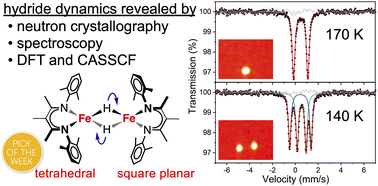
Chem. Sci., 2023,14, 2303-2312
https://doi.org/10.1039/D2SC06412J
A mitochondria-localized iridium(III) photosensitizer for two-photon photodynamic immunotherapy against melanoma
An iridium(III) two-photon photosensitizer was demonstrated to effectively trigger melanoma cell death by a combination of ferroptosis and ICD, and also cause the systemic induction of an immune response.
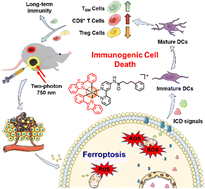
Chem. Sci., 2023,14, 1461-1471
https://doi.org/10.1039/D2SC06675K
Alkaline earth metal-assisted dinitrogen activation at nickel
Rare examples of trinuclear [Ni–N2–M–N2–Ni] core (M = Ca, Mg) with linear bridged dinitrogen ligands are reported in this work.

Dalton Trans., 2024,53, 4689-4697
https://doi.org/10.1039/D3DT03984F
Exploring binding preferences: Cu(II), Ni(II), and Zn(II) complexes of mycobacterial GroEL1 His-rich and Glu/His-rich domains
This study contrasts the Cu(II)/Ni(II)/Zn(II) complex stability of GroEL1 C-terminal domains: His-rich ABS (M. abscessus) and Glu/His-rich XEN (M. xenopi). ABS forms more stable complexes, favoring histidine over glutamic acid for metal ion binding.

Dalton Trans., 2024,53, 4054-4066
https://doi.org/10.1039/D3DT03579D
Luminescent lanthanide complexes based on 4,5-di(3,5-dicarboxylphenoxy)phthalic acid as enhanced fluorescence probes for highly selective detection of lead(II) ions in water
Eu(III) and Tb(III) complexes with specific fluorescence-enhanced detection performance for Pb2+ ions. The Eu(III) complex exhibits the lowest detection limit for Pb2+ ions among the systems described.

Dalton Trans., 2024,53, 3825-3835
https://doi.org/10.1039/D3DT04118B
A cross-metathesis approach for polymetallic [FeFe]-hydrogenase mimics
Diverse [FeFe]-H2ase mimics are available by cross-metathesis of [FeFe]-H2ase mimics bearing a double bond in the ADT-bridge nitrogen moiety and vinylmetallocenes, vinyl half-sandwich, or octahedral Ir-complexes.
![Graphical abstract: A cross-metathesis approach for polymetallic [FeFe]-hydrogenase mimics](/en/Image/Get?imageInfo.ImageType=GA&imageInfo.ImageIdentifier.ManuscriptID=D3DT04197B&imageInfo.ImageIdentifier.Year=2024)
Dalton Trans., 2024,53, 3756-3764
https://doi.org/10.1039/D3DT04197B
A monofunctional Pt(II) complex combats triple negative breast cancer by triggering lysosome-dependent cell death
A monofunctional Pt(II) complex PtL induces DNA single-strand breaks in triple negative breast cancer and triggers lysosome-dependent cell death by modulating lysosomal function.

Dalton Trans., 2024,53, 3808-3817
https://doi.org/10.1039/D3DT03598K
Transferrin-inspired iron delivery across the cell membrane using [(L2Fe)2(μ-O)] (L = chlorquinaldol) to harness anticancer activity of ferroptosis
Don't waste good iron for nails (or good men for soldiers) but save it for treating cancer! The lipophilic Fe(III) chelator chlorquinaldol has the remarkable ability to transport iron across the cell membrane afford potent broad-spectrum in vitro anticancer activity against a panel of cancer cell lines.
![Graphical abstract: Transferrin-inspired iron delivery across the cell membrane using [(L2Fe)2(μ-O)] (L = chlorquinaldol) to harness anticancer activity of ferroptosis](/en/Image/Get?imageInfo.ImageType=GA&imageInfo.ImageIdentifier.ManuscriptID=D3DT02517A&imageInfo.ImageIdentifier.Year=2024)
Dalton Trans., 2024,53, 3206-3214
https://doi.org/10.1039/D3DT02517A
The role of the terminal cysteine moiety in a metallopeptide mimicking the active site of the NiSOD enzyme
The wtCC peptide exhibits a high metal binding ability. The catalytic activity of the nickel(II) complex is similar to that of the nickel complex of the native NiSOD fragment.
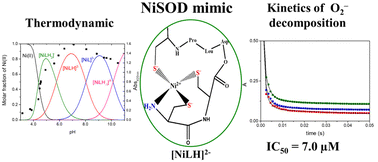
Dalton Trans., 2024,53, 1648-1656
https://doi.org/10.1039/D3DT03638C
Hyphenation of lipophilic ruthenium(II)-diphosphine core with 5-fluorouracil: an effective metallodrug against glioblastoma brain cancer cells
The anticancer antimetabolite, 5-fluorouracil (5-FU) is caged within a lipophilic Ru(II)-diphosphine (dppe) core in [RuII(dppe)2(5-FU)]PF6 (Ru-DPPE-5FU), and its therapeutic potential towards LN229 glioblastoma cells was evaluated.
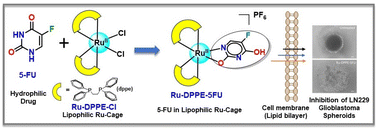
Dalton Trans., 2024,53, 1551-1567
https://doi.org/10.1039/D3DT02941G
Oxidation-derived anticancer potential of sumanene–ferrocene conjugates
Application of ferrocenium-containing sumanene buckybowl derivatives as innovative, effective, and selective anticancer agents is described.

Dalton Trans., 2024,53, 56-64
https://doi.org/10.1039/D3DT03810F
About this collection
Metal ions and coordination complexes are found in many aspects of biology, including in the transport of molecules, enzymatic systems, and medical applications. This Spotlight Collection aims to highlight recent developments in the general area of bioinorganic chemistry, incorporating metalloenzymes, bio-inspired chemistry, spectroscopic investigations (structural and electronic properties), metals in biology and medicine, and metalloneurochemistry.
This Dalton Transactions and Chemical Science joint collection is guest edited by Prof. Serena DeBeer (Max Planck Institute for Chemical Energy Conversion, Germany), Prof. Abhishek Dey (Indian Association for the Cultivation of Science, India), and Dalton Transactions Associate Editor Prof. Mi Hee Lim (Korea Advanced Institute of Science and Technology (KAIST), South Korea).
The collection brings together work from across bioinorganic chemistry, highlighting recent advances and future prospects for this growing area. Articles will be added to this themed collection as soon as possible after they are published. Please return to this page frequently to see the collection grow!
If you would like to contribute an article to this collection, please contact the Editorial Office at dalton-rsc@rsc.org with your proposed topic.